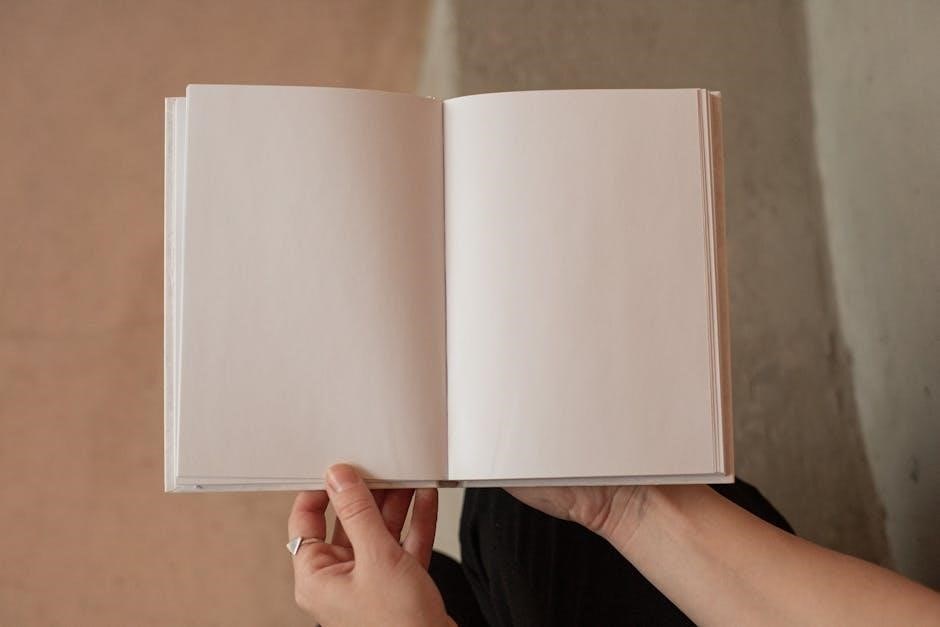This guide introduces the importance of journal size, impacting writing comfort, sketching space, and portability. It explores various sizes, materials, and trends to help you choose the perfect fit.
1.1 Importance of Choosing the Right Journal Size
Choosing the right journal size is vital for comfort, creativity, and practicality. A well-sized journal ensures ease of use, whether for writing, sketching, or carrying on-the-go. It impacts productivity and enjoyment, making it essential to match size with purpose. The right size enhances portability, ensuring your journal is always accessible. It also reflects personal style and needs, catering to individual preferences for space and usability. This foundational choice sets the tone for a fulfilling journaling experience.
1.2 Brief Overview of Journal Sizes
Journals come in a variety of sizes to suit different needs and preferences. Common sizes include A-series (A5, A6) and inch-based measurements (3×5, 5×8). These dimensions cater to tasks like note-taking, sketching, or travel documentation. Materials and binding styles further enhance functionality, ensuring durability and comfort. Whether for personal use or professional purposes, the diverse range of journal sizes offers something for everyone, making it easy to find a format that aligns with individual goals and lifestyles.

Common Journal Sizes
Journals are available in standard sizes like A5, A6, 3×5, and 5×8 inches, offering versatility for note-taking, sketching, and travel documentation while ensuring portability and practicality.
2.1 Standard Journal Sizes (A-Series, Inch-Based, etc.)
Standard journal sizes include A4, A5, and A6 in the A-Series, as well as inch-based sizes like 3×5, 5×8, and 8.5×11 inches. These sizes are widely recognized and offer versatility for various needs, from professional note-taking to personal sketching. A4 and 8.5×11 are ideal for detailed work, while A5 and 5×8 provide a balanced space for everyday use. A6 and 3×5 are compact, perfect for on-the-go jotting, ensuring there’s a size to suit every preference and purpose.
2.2 Popular Journal Sizes for Different Uses
Popular journal sizes cater to specific needs, ensuring optimal usability. For bullet journalism, A5 (5.83×8.27 in) is favored for its balanced space. Travel journals often use A6 (4.13×5.83 in) or 3×5 inches for portability. Professional note-taking benefits from A4 (8.27×11.69 in) or 8.5×11 inches, offering ample room for detailed entries. Sketching journals may opt for larger sizes like A3 or 11×14 inches, while minimalist diaries prefer compact options like 3.5×5.5 inches, ensuring versatility for every purpose.

Factors Influencing Journal Size Selection
Journals are chosen based on purpose, portability, and personal preference, ensuring comfort and practicality for writing, sketching, or travel, while accommodating individual needs and lifestyles effectively.
3.1 Purpose of the Journal (Personal, Professional, Travel, etc.)
The purpose of a journal significantly influences its size. Personal journals for daily reflection may be compact, while professional journals for meetings or note-taking often require larger formats. Travel journals might need durable, portable designs to accommodate memorabilia. Sketching or art journals demand ample space for creativity. Ultimately, the intended use dictates the ideal size, ensuring functionality and comfort for writing, organizing, or artistic expression, making it essential to align size with purpose for optimal effectiveness.
3.2 Portability and Convenience
Portability and convenience are key factors in choosing a journal size. Compact journals, like pocket-sized options, are ideal for carrying in bags or purses, making them accessible anywhere; Larger journals may offer more writing space but can be less convenient for on-the-go use. The right size balances ease of transport with usability, ensuring your journal is always ready when inspiration strikes, whether you’re traveling, working, or relaxing at home.
3.3 Personal Preference and Comfort
Personal preference and comfort play a significant role in selecting a journal size. Some prefer larger journals for expansive writing, while others favor smaller sizes for a cozy feel. Hand size, writing style, and ergonomic comfort are key considerations. A journal that feels right in your hands ensures a enjoyable experience, making it easier to express thoughts and ideas without discomfort or strain, whether for daily reflection, sketching, or professional use.

Materials and Binding Options
This section explores the variety of materials and binding options available for journals, emphasizing durability, aesthetic appeal, and sustainability to suit every user’s needs and preferences.

4.1 Paper Quality and Thickness
Paper quality and thickness significantly impact the journaling experience. Thicker, high-quality papers minimize bleed-through and feathering, ensuring smooth writing. Options range from 80gsm for everyday use to 100gsm or more for professional or artistic purposes; Acid-free and archival-grade papers are ideal for longevity.Textures like smooth, dotted, or grid layouts cater to different preferences, enhancing readability and creativity. Choosing the right paper ensures comfort and durability for various journaling needs, from personal reflections to detailed sketches or calligraphy.
4.2 Cover Types (Hardcover, Softcover, Leather, etc.)
Cover types significantly influence a journal’s durability and aesthetic appeal. Hardcover journals offer superior protection and a professional look, making them ideal for long-term use or special projects. Softcover options are lightweight and flexible, perfect for everyday carry. Leather covers provide a luxurious feel and exceptional durability, often preferred by professionals. Additionally, Fabric covers offer a soft, elegant appearance. The choice of cover material depends on personal preference, intended use, and desired longevity, ensuring the journal remains a trusted companion for all writing needs.
4.3 Binding Styles (Sewn, Glued, Spiral, etc.)
Binding styles play a crucial role in a journal’s functionality and longevity. Sewn binding is durable and allows pages to lie flat, ideal for frequent use. Glued binding is cost-effective but less sturdy, suitable for casual use. Spiral binding offers 360-degree flexibility, perfect for sketching or note-taking. Each style caters to different needs, ensuring the journal remains functional and visually appealing over time.

Specialized Journal Sizes
Explore unique sizes tailored to specific needs, like mini journals for portability or large formats for sketching. These niche sizes enhance functionality for dedicated uses.
5.1 Mini and Pocket Journals
Mini and pocket journals are ideal for on-the-go use, offering portability and convenience. Typically measuring 3×5 inches or smaller, these compact journals fit easily into bags or pockets, making them perfect for quick notes, ideas, or daily reflections. Their small size allows for discreet use in any setting, while still providing enough space for meaningful writing or sketching. Many users appreciate their lightweight design and ability to capture thoughts spontaneously, making them a favorite for travelers and busy individuals alike.
5.2 Large and Oversized Journals
Large and oversized journals, often measuring 8.5×11 inches or larger, provide ample space for writing, sketching, or creating detailed layouts. These journals are ideal for artists, designers, or those who prefer a generous canvas for expression. While they may be less portable than smaller sizes, their expansive pages offer comfort for large handwriting or intricate artwork, making them a favorite for creative projects and visual planning. Their size ensures readability and ease of use, though they may require more storage space.
5.3 Niche Sizes (Travel, Sketching, etc.)
Niche journal sizes cater to specific needs, such as travel, sketching, or specialized writing. Travel journals often feature compact sizes with space for maps and itineraries, while sketching journals may have larger, high-quality paper for art. Waterproof or weather-resistant options are ideal for outdoor use. These specialized sizes ensure functionality for particular activities, blending practicality with personal preference to enhance creativity and organization in unique ways.

Trends and Innovations in Journal Sizing
Modern trends include eco-friendly materials, customizable sizes, and digital integration, offering users sustainable, personalized, and tech-enhanced journaling experiences to suit evolving preferences and needs efficiently.
6.1 Sustainable and Eco-Friendly Options
Eco-friendly journals are gaining popularity, featuring recycled paper, biodegradable covers, and sustainable materials. Bamboo and plant-based inks are increasingly used, reducing environmental impact. Many brands now prioritize recyclable packaging and ethical production processes, aligning with global sustainability goals. These options cater to environmentally conscious consumers without compromising on quality or functionality, making journaling a greener and more responsible choice for modern users.
6.2 Customizable and Adjustable Sizes
Modern journals now offer customizable and adjustable sizes, catering to individual preferences. Users can tailor dimensions, page layouts, and even binding styles to suit their needs. Some brands provide interchangeable inserts, allowing for personalized organization. This trend emphasizes flexibility, enabling journals to adapt to various uses, from daily notes to artistic projects. Customizable options attract a diverse audience, ensuring the perfect fit for every user’s lifestyle and creative demands.
6.3 Digital Integration and Smart Journals
Smart journals now integrate digital features, blending traditional writing with modern technology. Many offer app connectivity, allowing users to sync handwritten notes digitally. Some models include touchscreens or voice-to-text capabilities, enhancing versatility. These journals often feature adjustable settings, like customizable templates and digital backups, ensuring content is easily accessible. This fusion of analog and digital tools appeals to tech-savvy users, providing a seamless and organized journaling experience while maintaining the tactile charm of physical writing.
Selecting the right journal size is crucial for enhancing your writing experience. Consider purpose, portability, and personal preference to find your perfect fit. Experiment to discover the ideal journal for your needs.
7.1 Final Thoughts on Selecting the Right Journal Size
Selecting the right journal size is a balance of practicality and personal comfort. Whether for daily notes, sketching, or travel, choosing a size that aligns with your lifestyle ensures satisfaction. Consider how often you’ll carry it, the space needed for writing or art, and how it feels in your hands. Experiment with different sizes to find what works best for you and enhances your journaling experience.
7.2 Encouragement to Experiment and Find the Perfect Fit
Don’t hesitate to explore different journal sizes and formats until you find what truly resonates with you. Journaling is a personal journey, and the right size can enhance your experience. Whether you prefer compact portability or expansive space for creativity, experimenting with various options will help you discover your ideal match. Embrace the process of finding the perfect fit—it’s a step toward making journaling a meaningful and lasting habit in your life.
